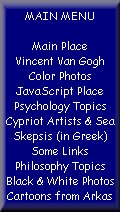PERCEPTUAL
ORGANIZATION AND VISUAL ILLUSIONS
(The importance
of Gestalt Psychology)
PERCEPTUAL
ORGANIZATION AND VISUAL ILLUSIONS
(The importance
of Gestalt Psychology)
| Perceptual
Organization (based on Gestalt Psychology): Gestalt schools
of psychology say that people perceive and experience objects as whole
patterns. We don't focus on parts but rather we see them as part of the
whole. Perceptual organization is a process involving distinction
of "figures" from the "ground". Figures are the objects or parts perceived
to stand apart from the background. Ground is the background against which
the figure appears.
Visual Illusion: is a situation where the sensory cues create perceptual experiences that may (or may not) correspond to what is out there in the real world.
|

|